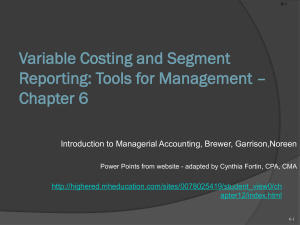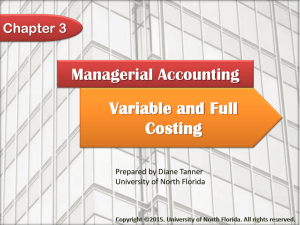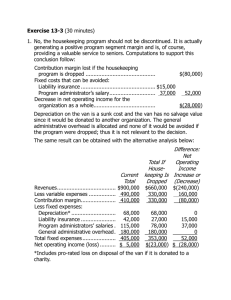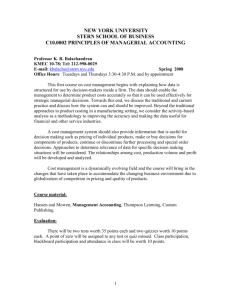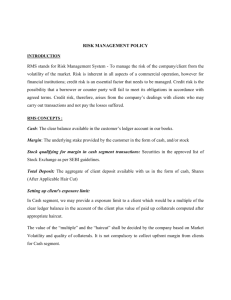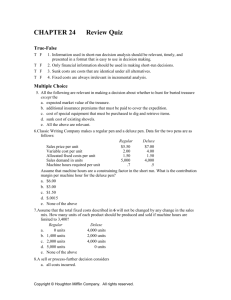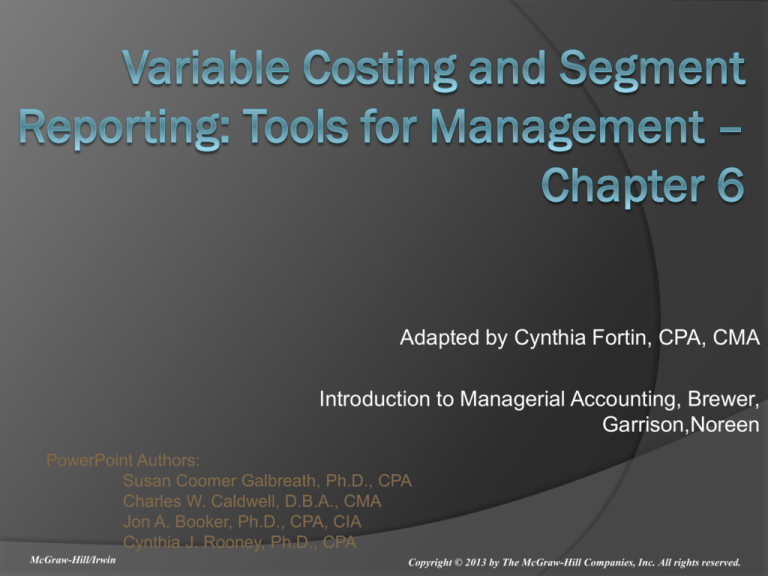
Adapted by Cynthia Fortin, CPA, CMA
Introduction to Managerial Accounting, Brewer,
Garrison,Noreen
PowerPoint Authors:
Susan Coomer Galbreath, Ph.D., CPA
Charles W. Caldwell, D.B.A., CMA
Jon A. Booker, Ph.D., CPA, CIA
Cynthia J. Rooney, Ph.D., CPA
McGraw-Hill/Irwin
Copyright © 2013 by The McGraw-Hill Companies, Inc. All rights reserved.
Pricing: Zappos case
http://video.wileyaccountingupdates.com
/2011/01/07/pricing/
6-2
Variable Costing vs Absorption Costing
Variable
Costing
Absorption
Costing
Direct Materials
Product
Costs
Direct Labor
Variable Manufacturing Overhead
Product
Costs
Fixed Manufacturing Overhead
Period
Costs
Variable Selling and Administrative Expenses
Fixed Selling and Administrative Expenses
Period
Costs
6-3
Total
Direct materials (DM)
Direct Labor (DL)
Variable Mfg Overhead ( V OH)
Fixed Mfg OH
# units produced
= Unit product Cost
6-4
Total
Direct materials
Direct Labor
Variable Mfg OH
# units produced
Variable costing
= Unit product Cost
6-5
Unit Cost Computations
Harvey Company produces a single product
with the following information available:
6-6
Unit Cost Computations
Unit product cost is determined as follows:
6-7
Income Statements
Assume the following additional information
20,000 units were sold during the year at a
price of $30 each.
There is no beginning inventory.
6-8
Variable Costing Contribution
Format Income Statement
Contribution margin = Sales – Variable expenses.
Variable Costing
Sales (20,000 × $30)
Less variable expenses:
Variable cost of goods sold (20,000 × $10)
Variable selling & administrative
expenses (20,000 × $3)
Total variable expenses
Contribution margin
Less fixed expenses:
Fixed manufacturing overhead
Fixed selling & administrative expenses
Net operating income
$ 600 000
$ 200 000
60 000
260 000
340 000
$ 150 000
100 000
250 000
$ 90 000
6-9
Absorption Costing Income Statement
Gross margin is not Contribution margin
Fixed manufacturing overhead deferred in
inventory is 5,000 units × $6 = $30,000.
6-10
Comparing the Two Methods
5000*$10
5000*$6
6-11
Income
Statement
Format
Net Income
Variable Costing
Absorption Costing
Contribution
margin
Gross margin
F Mfg O/H not
Portion F Mfg O/H
included in ending included in ending
inventory.
inventory units.
Included in period
expense.
6-12
Summary of Key Insights
6-13
6-14
Decentralization and Segment
Reporting
An Individual Store
Quick Mart
Segment
part of an organization
about which
management seeks
cost, revenue, or
profit data.
A Sales Territory
A Service Center
6-15
Segmented Income Statement
Contribution
format
Separates
Variable
From Fixed
expenses
Traceable fixed costs should
be separated from common
fixed costs to enable the
calculation of a segment
margin.
6-16
Identifying Traceable Fixed Costs
Traceable fixed costs
Disappear if the segment itself disappeared.
No computer
No computer
division means . . . division manager.
6-17
Common fixed costs
overall operation would not disappear if
any particular segment were eliminated.
No computer
division but . . .
We still had the CEO
Dazong Wang, former
CEO of one of China’s
largest automakers
6-18
Heating a Carrefour store is
common to all departments
6-19
First class
business
landing fee
traceable to flight not
classes
economy
6-20
Segment Margin =
Contribution margin - traceable fixed costs
of a segment
best gauge of the longrun profitability of a
segment.
6-21
Traceable and Common Costs
Fixed
Costs
Traceable
Don’t allocate
common costs to
segments.
Common
6-22
Levels of Segmented Statements
Webber, Inc., has two divisions.
Webber, Inc.
Computer Division
Television Division
6-23
Levels of Segmented Statements
Our approach to segment reporting uses the
contribution format.
Income Statement
Contribution Margin Format
Television Division
Sales
Variable COGS
Other variable costs
Total variable costs
Contribution margin
Traceable fixed costs
Division margin
$ 300 000
120 000
30 000
150 000
150 000
90 000
$ 60 000
Cost of goods
sold consists of
variable mfg
costs.
Fixed and
variable costs
are listed in
separate
sections.
6-24
Levels of Segmented Statements
Sales
Variable costs
CM
Traceable FC
Division margin
Common costs
Net operating
income
Income Statement
Company
Television
$ 500,000
$ 300,000
230,000
150,000
270,000
150,000
170,000
90,000
100,000
$ 60,000
Computer
$ 200,000
80,000
120,000
80,000
$ 40,000
6-25
Levels of Segmented Statements
Sales
Variable costs
CM
Traceable FC
Division margin
Common costs
Net operating
income
Income Statement
Company
Television
$ 500,000
$ 300,000
230,000
150,000
270,000
150,000
170,000
90,000
100,000
$ 60,000
25,000
$
75,000
Computer
$ 200,000
80,000
120,000
80,000
$ 40,000
Common costs should not
be allocated to the
divisions. These costs
would remain even if one
of the divisions were
eliminated.
6-26
Omission of Costs
Costs assigned to a segment should include all
costs attributable to that segment from the
company’s entire value chain.
Business Functions
Making Up The
Value Chain
R&D
Product
Design
Customer
Manufacturing Marketing Distribution Service
6-27
Inappropriate Methods of Allocating Cost
Among Segments
Failure to trace
costs directly
Segment
1
Segment
2
Inappropriate
allocation base
Segment
3
Segment
4
6-28
Common Costs
should not be arbitrarily allocated to
segments
1. May make a profitable business
segment appear to be unprofitable.
2. Allocating common fixed costs forces
managers to be held accountable for
Segment
Segment
Segment
costs they cannot
control.
2
3
4
6-29
Companywide Income Statements
Both U.S. GAAP and
IFRS require absorption costing
for external reports.
6-30
Variable versus Absorption
Costing
Fixed manufacturing
costs must be assigned
to products to properly
match revenues and
costs.
Absorption
Costing
Fixed manufacturing
costs are capacity costs
and will be incurred
even if nothing is
produced.
Variable
Costing
6-31
Segmented Financial Information
Both U.S. GAAP and IFRS require
publically traded companies to
include segmented financial data in
their annual reports.
Global View
6-32
But
Companies must report
segmented results to
shareholders using the
same methods that are
used for internal
segmented reports.
6-33
This
requirement
motivates
managers
to avoid
using the
contribution
approach
for internal
reporting
purposes.
6-34
because if they did they would
be required to:
a. Share this
sensitive data
with the public.
b. Reconcile these
reports with
applicable rules
for consolidated
reporting
purposes.
6-35

